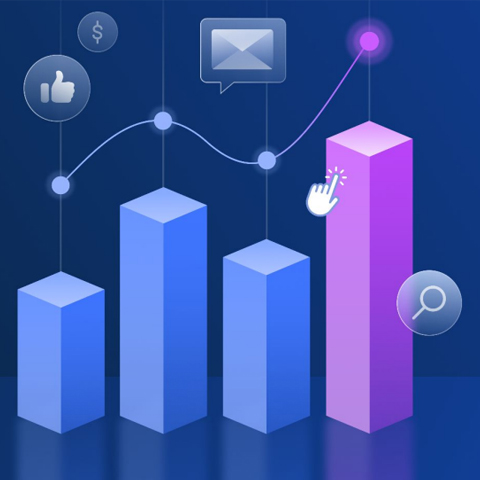Data Management Platforms Demystified: Using Actionable Marketing Data to Target, Segment, and Generate Revenue

Collecting, analyzing, managing, and acting on first-party and third-party data is a complex challenge. As an advertiser, agency or publisher, you need the right tool to manage your critical audience data assets. If you want to truly understand your customers, you need a data management platform. You’ve probably heard a lot about DMPs, but what exactly are they and do you need one? This whitepaper will present a detailed look at DMPs providing insights into how they work, what they’re used for, and the results you can expect.
Get the downloadBelow is an excerpt of "Data Management Platforms Demystified: Using Actionable Marketing Data to Target, Segment, and Generate Revenue". To get your free download, and unlimited access to the whole of bizibl.com, simply log in or join free. |

|
What is a data management platform? Do you need one? Find out how data management platforms can help you achieve unprecedented targeting precision and scale across all of your online advertising programs.
Executive Summary
The term data management platform (DMP) is tossed around lightly by many advertising technology providers. But true, robust, and scalable DMPs are few and far between. In this whitepaper, marketers and agencies will learn the following:
- What is a DMP?
- What can a DMP do for you and your advertising program?
- Do you need a DMP, what to look for, and how do you implement one?
- How do you integrate existing data assets, advertising platforms, and campaign performance systems?
- What can you achieve in terms of improved targeting, audience segmentation, and operational efficiency?
This whitepaper delivers an in-depth overview of DMPs and provides actionable and useful information for marketers and agencies hoping to implement a DMP to improve program outcomes.
Introduction
Marketers and agencies are always working to better understand their customers. They are constantly asking the following key questions:
- Who are your customers?
- What attributes define them?
- Which exact products are they currently in market to buy?
- What are they likely to buy next? • How do you reach more of them?
- How safe is this customer data and are you leaking gold without knowing it?
By analyzing a wealth of both first-party and third-party demographic, contextual, and behavioral data about customers and campaigns, you can answer these questions. Marketers, agencies, and publishers can use this data to deliver targeted, one-to-one messages to consumers at the exact moment in the purchase process that customers are ready to buy.
But collecting, analyzing, managing, and acting on this first-party and third-party data is a complex challenge. As an advertiser, agency, or publisher, you need the right tool to manage your critical audience data assets. If you want to truly understand your customers, you need a data management platform.
You’ve probably heard a lot about DMPs, but what exactly are they and do you need one? This whitepaper will present a detailed look at DMPs providing insights into how they work, what they’re used for, and the results you can expect.
At their core, DMPs are buyer-side platforms that allow advertisers and agencies to take control of their own first-party audience and campaign data, compare it to third-party audience data, and make smarter media buying and campaign planning decisions. Slice your own online and offline first-party data to create audience segments for display, search, video, and social campaigns. Apply it to ad campaigns targeting audiences across the purchase funnel. Get visibility into the ROI each campaign delivers for each segment. DMPs also allow marketers to pull in and analyze all audience data—including third-party data—to present a 360-degree view of how campaigns perform against specific target audiences.
A DMP can help advertisers and agencies solve their most pressing challenges. By putting audience data at the center of all their online advertising programs, advertisers and agencies can answer the following questions:
- What are the specific targetable attributes of your audience throughout the purchase funnel?
- How can you leverage your own first-party online and offline audience data to more effectively target campaigns?
- How can you use insights from the data to perfect audience segmentation and increase campaign scale?
- How do you gain visibility into cross-platform performance metrics so you can adjust campaign parameters in real time?
- How can you effectively analyze large quantities of audience data to make smarter media buying and campaign planning decisions?
Data Management Platform Overview
DMPs are fast becoming critical tools for marketers and agencies looking to better leverage their customer data.
What is a data management platform?
Simply put, a DMP forms the backbone of all online advertising operations for an economy that is becoming increasingly more digitized.
While several technology companies claim to provide DMPs, a real DMP provides marketers with centralized control of all of their audience and campaign data. It helps them manage and analyze this data to craft, target, and optimize campaigns that reach more of the right people and drive improved ROI from their media spend.
A centralized data management platform allows you to create target audiences based on a combination of in-depth first-party and third-party audience data. You can more accurately target campaigns to these audiences across thirdparty ad networks and exchanges and measure with accuracy which campaigns performed the best across segments and channels to refine media buys and ad creative over time.
A DMP must be able to not only analyze a user’s first-party online and offline data, but also pull in data from thirdparty data sources to give you rule-based control over audience definition and ad distribution to demand-side platforms (DSPs), ad networks, ad exchanges, and publishers.
Using a DMP as opposed to a spreadsheet, a marketer or agency account manager can manage the day-to-day plumbing of all online advertising campaigns in one dashboard from campaign creation, audience profiling, media buying, and targeting to optimization, measurement, and reporting. An enterprise-class DMP can scale to billions of data points. This enables marketers to get high-level and granular insights into campaigns that are working across various channels, understand which exact audiences specific campaigns are reaching, and determine what changes to make to be more effective.
Who can benefit from a data management platform?
Advertisers and agencies today are faced with unprecedented challenges. With increasing competition and entrenched consumer ad blindness, brands must find ways to reach precisely defined audiences with relevant messages at the right time in the purchase funnel or risk losing sales to competitors.
Yet few marketers are effectively analyzing all their disparate audience and campaign data to make better media buying decisions, more effectively target campaigns, and optimize creative to drive higher brand awareness and conversion. Instead of taking a data-driven approach to campaign management, many marketers have increased the number of campaigns across multiple channels (display, search, social, video, and so on) in a bid to reach more consumers. This fragmented approach—made ever more challenging by the complex ecosystem of ad networks, exchanges, DSPs, and bidding platforms—has resulted in a decrease in overall marketing ROI.
Do you need a data management platform?
If you answer yes to more than three of these questions, you need a DMP.
- Do you manage multiple online campaigns across different ad networks, exchanges, and publishers?
- Do you want to ensure you have control over your data assets, maximize segmentation, prevent leakage, and monitor partner usage?
- Do you currently run retargeting? Would you like to enhance your scalability, niche-targeting, and messaging capabilities?
- Do you want to better target campaigns to improve response rates, conversion, and brand recognition?
- Do you buy media placements, buy third-party audience data, or bid on ad exchanges on a regular basis?
- Do you want to control advertising costs and improve overall ROI?
- Do you need to extend a data-centric strategy beyond digital?
Marketers
Marketers stand to benefit greatly from DMPs because these platforms help them achieve better campaign performance and overall ROI. Within a marketing organization, there are three main users of DMPs and each will use the platform according to their unique needs. Here are some ways that specific users in a marketing organization use DMPs to improve success in their everyday jobs.
Vice President of Marketing
- Empower teams to buy audiences with minimal waste and scalable insights.
- Test offline models online.
- Leverage current customer relationship management (CRM) and lifetime value (LTV) strategies for real-time decision making and campaign enhancement.
- Segment once, target anywhere.
- Tailor messages to audiences based on prior behaviors and interactions both onsite and offsite.
- Find abandoners from your site and figure out why they left.
- Mine audience data from your site to get an enhanced understanding of customers and to improve campaign messages and efficiency.
- Engage in brand-safe data mining and usage that’s compliant with or ahead of legislation.
- House all audience data in one place where multiple partners can log in and use it based on predefined sharing and security parameters.
Site Operations and Information Technology
- Prevent latency and circumvent traffic issues on your site.
- Ensure the security of your site for all customers.
- Own your data and control exactly who has access to it.
- Minimize amount of tags on your pages.
- Analyze site traffic and patterns to get insights into customer interaction.
- Increase conversions on your site.
- Enable a support team to quickly address quality assurance issues.
Privacy and Legal
- Have a tight legal contract with restrictions and compliance to company policy, including a quickly executable opt-out clause.
- Include information on privacy and marketing uses of technology on the site.
- Be at the forefront of privacy policy and impending legislation.
Agencies
Digital agencies today are in a competitive race to better serve their marketing clients, creating and delivering high-impact campaigns that reach the right audiences at the right time in the purchase cycle to measurably boost marketing ROI across segments and channels. Agencies stand to benefit greatly from DMPs because they can use them to centralize client audience data to make better media buying decisions and optimize programs based on up-to-the-minute campaign and audience analysis. Here’s how key positions at an agency can use a DMP.
Account Director
- Understand competitive landscape and client’s role and position.
- Empower planners to execute quickly, easily, and with intelligence.
- Streamline account management by centrally housing all client audience data.
- Keep a record of the performance and ROI of past plans and campaigns.
- Innovate on campaign creative, targeting, and delivery.
- Know exactly what kind of audience data you are buying and how it performs.
Media Planner
- Spend client dollars efficiently and predictably with the best possible results.
- Buy audience-targeted impressions (reach, scale, and discovery) and get access to flexible, graphical reports that are easily shared.
- Simplify planning to use fewer but stronger data, media buying, and ad network partners.
- Implement a smooth planning process from request for proposal (RFP) and launch to reporting and analysis.
- House all client audience data in one place for deduplication, scalability, and insights.
- Optimize all media buys and campaigns based on detailed reporting.
What can a data management platform do for you?
DMPs not only help advertisers and agencies improve the overall efficiency and ROI of their online advertising programs, but DMPs can also be used in specific cases to deliver targeted results. There are a few typical use cases that advertisers can achieve with DMPs to improve specific components of their digital advertising programs.
What can a data management platform help you achieve?
A DMP helps marketers and agencies perform a number of key functions.
- Retargeting: Easily implement customized retargeting campaigns based on specific activities and behaviors taken on or offline.
- Prospecting: Seamlessly integrate with third-party audience data sources to acquire anonymous data to achieve higher precision and scale with targeting campaigns.
- Site Optimization: Use first- or third-party data to determine customized content for different consumers when they come to your website.
- Audience Intelligence: Contrast your site audience against third-party data sources to learn more about specific audience attributes to target more likely converters.
- Better ROI: Use centralized media performance analytics to determine which audience performed best and where to focus in the future.
Data Management Platforms: A Deeper Dive
DMPs and advanced DMPs offer considerable benefits to users.
What main features should your data management platform offer?
Every DMP should offer a full-featured set of components that allow marketers to mine their own first-party data to get a deeper understanding of their customers and make more accurate audience buys. A DMP platform should allow you to segment once, target anywhere by leveraging existing CRM and LTV strategies to make real-time and long-term campaigns decisions. Following are five features every DMP should offer:
Data Collection: Every DMP should allow you to easily collect your first-party audience data in one place. This is usually done by placing a single tag on your site that brings all of your first-party data into the DMP. Your DMP should also allow you to import data from third-party data providers and other players in the online advertising ecosystem so you can compare these data points against your own first-party data in one centralized place. Make sure you can also import offline data from your own CRM systems so you can analyze in-store behaviors, consider past purchases, and target users anonymously online.
Data Classification: Once you have all your first-party audience data in one place in the DMP, it should allow you to quickly organize this data into taxonomies. How you organize the data will depend on your business. An e-commerce site might use a DMP to classify purchase data into descending taxonomies such as clothing, kids, boys, shoes, sneakers, and so forth. Classifying your site data into taxonomies like this is the first step toward building distinct audience profiles.
Data Analysis: Once you’ve classified your first-party data into taxonomies, you can begin to analyze it to more clearly understand customer intent. By analyzing data about visitors’ past purchases, clicks, preferences, and propensity to respond to certain offers, you can begin to use these insights to create specific customer segments.
Data Transfer: Once you’ve collected, classified, and analyzed your first-party audience data in your DMP, you should then be able to leverage that data by transferring it directly to the largest ad networks, exchanges, portals, DSPs, and trading desks to make accurate media buys targeting your predefined segments. Your DMP should work seamlessly with the largest players in the display, search, and social advertising ecosystems.
Scalability: Today most companies face a data deluge. From audience data, CRM data, campaign data, third-party audience data, and beyond, marketers and publishers have millions of data points at their disposal. A DMP must be able to scale to millions of data points and analyze all of these simultaneously to deliver critical insights.
Look for a Privacy Expert in your Data Management Platform Provider
Collecting and analyzing first- and third-party audience data requires 100 percent compliance with privacy regulations. When choosing a DMP, a critical deciding factor should be the strength and reputation of its consumer data privacy and protection standards. Make sure the DMP you choose offers a white-label registry, providing complete transparency to consumers on the data that is collected when they navigate your website. Lastly, make sure your DMP providers can provide guidance and tactical solutions on transparent consumer opt-out option, data retention, and compliancy recommendation around new policies and browser do-not-track activities.
What do advanced data management platforms offer?
If you are a professional marketer committed to getting the absolute most out of every campaign—striving for maximum ROI and conversion optimization—then you’ll want a DMP that offers advanced features. If you need to maximize every marketing dollar spent, you need a powerful DMP that delivers deep, brand-safe data mining to empower media teams to buy target audiences with minimal waste and scalable insights. You should look for several key features in an enterprise-class DMP.
Tag Management
This feature enables marketers to actively monitor all of the tags that fire off of their sites, providing a robust interface for controlling secure data transfer, protecting latency, and monitoring tags. Advanced tag management should enable marketers to set up a spectrum of privacy and control measures for data access and sharing. It should also provide the ability to categorize and assign varying levels of rights to advertising partners. Tag-based audience management allows users to consolidate disparate audience data from multiple sources into one private hierarchical data taxonomy. Finally, look for features that will enhance your users’ experience including the ability to monitor pixel latency with policing features so you can leverage complex logic that turns off vendors who are slowing down page loads.
Audience Segmentation
You want the ability to achieve world-class audience segmentation by leveraging your own private first- and third-party data assets. A DMP should include a dashboard that allows marketers to slice their first-party data by taxonomy, segment, campaign, or ROI outcomes compared against third-party data. Advanced audience segmentation features go beyond simple targeting, enabling you to create thousands of highly-relevant segments within the DMP to reach audiences with the right message at different stages of the purchase funnel. These audiences can be broad or granular. For example, you might create an audience segment such as women shoppers who frequently buy shoes and respond to free-shipping offers.
Media Integration
An advanced DMP allows marketers to easily share their audience segments with ad networks, trading desks, portals, and DSPs to serve targeted ads and reach audiences in real time. By using your DMP to safely and securely share your data with these partners, you can plug and serve highly targeted ads to your predefined target audiences across the web. Your DMP should also enable you to seamlessly and efficiently share your audience data with your agency partners who make media buying decisions.
Campaign Analytics
With all this critical audience data in your DMP, you need an easy-to- use tool to understand it. An advanced DMP should provide a single dashboard where you can measure and compare campaign performance for specific audiences across digital channels—including display, video, search, and so forth—replacing manually aggregated spreadsheets and reports. It’s critical this dashboard be easy to use for marketers—not made for IT—so you can clearly see campaign performance and optimize media spend based on your findings.
Audience Analytics
Aside from just seeing how campaigns are performing, an advanced DMP should show how your audiences are performing. Your DMP dashboard should provide clear insights into how an audience segment is performing at any given time. You should be able to measure how specific audiences interact with campaigns in each channel so you can see which channels deliver the highest ROI for specific segments. Your DMP should enable you to generate reports showing all data attributes associated with a specific audience from all available data sources so you can engage in new audience discovery, ongoing audience optimization, and expansion of your campaign reach to new segments.
Data Management Platform Checklist
Many companies offer dashboards of standalone features they claim are DMPs—but are not DMPs. A full-featured DMP offers all of the following features.
Tag Management
- Universal container tag
- Latency protection
- Custom latency windows setting
- Anonymous data pass with user privacy protection
- First-party data ingestion from site
- Pass data with service capability
- Pixel-less integration with web ecosystem
- Pixel audits
- Taxonomy tools to organize user data
- Data organization
- Universal ID synching
Audience Management
- On demand third-party data
- Third-party intent data access
- Exclusive third-party data partners
- First-party data organization
- Audience management user interface
- Data taxonomy search
- Data accounting
- Third-party data partner integration
- First-party data ingestion Major platform pre-integration
- Interplatform segment sharing
- End-to-end audience platform
- First-party data modeling with scale against large audience
- Custom audience segmentation
- Third-party intent data deduplication
- Boolean segment logic (and, or, not)
Marketing Analytics
- Campaign data ingestion
- Campaign data ingestion via APIs
- Dashboard setup in less than one week
- Scalable data storage and processing
- Robust interactive dashboarding
- Exportable reporting
- Audience data and media data housed in one platform
- User interface for visualization and reporting
- Shareable real-time reporting
- Offline data match technology
- Optimization modeling
- Audience analytics including look-alike modeling and discovery reports
- Audience inventory forecasting and projections
Data Management Platform: Getting Started
Now that you’ve decided a DMP is right for you, it’s time to get started. Implementing a DMP should be simple, as most DMP platforms are software as a service (SaaS) and require just a tag or two to be installed on your site. However, there are some critical steps you’ll want to consider before diving into the DMP game.
First Steps
A few key initial steps are necessary to get started with a DMP.
Identify Your Data
Valuable data exists in many shapes and forms, be sure you consider all types and sources of data. Data types you will want to analyze in your DMP include: page metadata, search queries, category names, product names and IDs, product prices, cart totals, order confirmations, data in your cookies, user engagements (video views, downloads, posts, and comments), offline store data, and so on. The sources of these data can be: your website, microsites, apps, email, CRM, web analytics, a data warehouse, or third-party marketing tools. Make sure to find all of your critical data, even if it means digging a bit.
Protect Your Consumers
Ask yourself if you would be comfortable showing your consumer all the detailed pieces of data you are collecting about them. If the answer is no for any element of the data, exclude it from your DMP data collection efforts. As a guideline, do not store data related to these general categories: personally identifiable information (PII) such as email address, phone number, full name, or anything that can be traced back to an individual; sensitive browsing behavior such as violence, drugs and alcohol, pornography, medical conditions, and so on; or any data on minors.
Let Experts Help You
You should make sure your DMP provider is staffed by data, privacy, and marketing experts who can help you collect and organize your data, while also ensuring it respects consumer privacy.
Implementing a Data Management Platform
Once the initial steps are complete, the next step is implementation.
Data Collection Implementation
First, you will need to implement a pipeline between your data sources and your DMP. For web data, this typically means implementing a data collection tag across areas of your site where users exhibit meaningful behavior. For offline data, this involves utilizing a match partner to match against a non-PII key that is present for users both offline and online.
Bucket User Action
Begin to classify user actions from the perspective of intent. Based on your data, organize users into four categories including interest, intent, initiation, and conversion.
Structure Your Data
Take a crack at organizing your data into a structure that makes sense for your business and advertising initiatives. A good starting point is your taxonomy. Think about the basis that you currently use to customize advertising messages to your consumers, such as product category, product, loyalty, price point, engagement level, and so on.
Classify Your Raw Data
Every raw private data point will need to be mapped to your data taxonomy. You may have a mapping already established. If not, most DMPs will offer professional classification services to help you with this or completely take it off your hands.
INTEREST - Merely interested in your product / service, such as reading an article or watching a video related to your product / service.
INTENT - Has the intent to buy, such as viewing a product page, conducting a search, or building a product / service.
CONVERSION - Has purchased the product / service or submitted their contact information.
INITIATION - Is about to complete a purchase, having added the product / service to their cart, began to fill out the lead gen form, etc.
Data Management Platform Ecosystem Touchpoints
A DMP touches many different aspects of your company’s business and many different external partners. There are a few critical points in your DMP ecosystem.
Your Agency
If your agency does all your media planning, they will most likely need to be educated on your DMP solution. Your DMP vendor should offer such training or may already have a partnership established with your agency, in which case your agency will be fully versed on the solution.
Your Company
Your DMP solution will touch several points of your infrastructure from both a technical and business perspective. On the technical front, your DMP will touch your site, apps, offline data store, and so forth. On the business front, your DMP will touch your marketing team, analytics team, development team, and operations and media planning team if you handle media planning in-house.
Your Media Sources
In order to transfer your data to your media sources, you will need to establish a business and technical handshake with your media sources. The business relationship will most likely already exist, but the technical integration may need to be implemented. A good DMP will have both a solid and pre-existing business and technical integration with your key media sources.
Common Pitfalls
If you have the right DMP partner, the road to implementation is usually smooth but there are a few pitfalls to avoid. Make sure to avoid the following problems by picking only a high-quality DMP.
Inflexible Technology
If your DMP solution requires you to sign in blood when it comes to setting the structure of your taxonomy, the DMP will inevitably turn into an expensive paperweight that limits your marketing team as your business expands and your marketing strategies evolve. From the beginning, make sure your taxonomy structure is as flexible as a yoga instructor with the option to change the data mapping (for example, productName=Basketball_Shoes now gets bucketed into active apparel rather than sports equipment) as well as the physical structure of the taxonomy (for example, moving, deleting, or renaming nodes).
Spreadsheet-Based Analytics
A robust DMP solution will include flexible reporting and analytics dashboards that enable real-time data computing and audience intelligence. DMPs should have real-time computing capabilities that allow you to store grouping and renaming of placements or creatives, save custom reports that are automatically updated, and create flexible custom metrics that are tailored to your needs. Do not accept complicated spreadsheets as a substitute for sophisticated data analytics.
Lack of Additional Data
A DMP is not only about organizing your own data, but also combining your data with third-party sources to drive more robust analytics, insights, and targeting. If your DMP does not naturally tie into third-party data sources from a technical and business perspective you may encounter the following issues:
- Need to strike net new business deals with third-party data providers.
- Need to implement one-off technical integrations with multiple third-party data providers.
- Need to incur additional third-party data costs.
- Inability to integrate with a valuable third-party data source.
A Flash-in-the-Pan Data Management Platform
The DMP market is being flooded with new players. Analyze business model, funding, reach, services and execution, and brand strength of each DMP provider and make sure you are confident they will still exist in the future. It is also important to examine the vision of the company.
Not Having a Data Management Platform
The bottom line is that a DMP is essential to organizing and managing your valuable first-party data assets. It will play an instrumental role in taking your online and offline advertising to the next level. With a DMP, you can begin to more deeply understand your consumers and their needs and deliver relevant and compelling marketing messages via any cross-channel marketing touchpoint including display, search, email, TV, radio, and mobile.
Conclusion
Advertisers and agencies today are engaged in a battle to find, target, and engage key audiences. In a world of increasing advertising noise and consumers who ignore one-size-fits-all messages, marketers need the most robust tools in their arsenals to effectively connect with audiences. To elevate their brands and products above the noise, smart marketers are putting data at the center of every advertising decision. With a data-driven approach to marketing, everyone wins. Consumers get relevant, timely, and engaging messages that resonate with their wants and needs. Advertisers connect with the right audiences at the right time in the purchase cycle, generating more sales and higher marketing ROI. And all of the players in the advertising ecosystem—marketers, agencies, ad networks and exchanges, DSPs, data providers, and publishers— are able to more efficiently manage their inventory and processes to deliver best-in-class results.
DMPs are the glue that hold all of a marketer’s key advertising data together. DMPs provide one comprehensive platform to help marketing organizations and their agencies take control and make sense of their private first-party data, achieve world class audience segmentation, reach targets everywhere, and create a closed-loop feedback for optimized media planning.
Want more like this?
Want more like this?
Insight delivered to your inbox
Keep up to date with our free email. Hand picked whitepapers and posts from our blog, as well as exclusive videos and webinar invitations keep our Users one step ahead.
By clicking 'SIGN UP', you agree to our Terms of Use and Privacy Policy


By clicking 'SIGN UP', you agree to our Terms of Use and Privacy Policy









